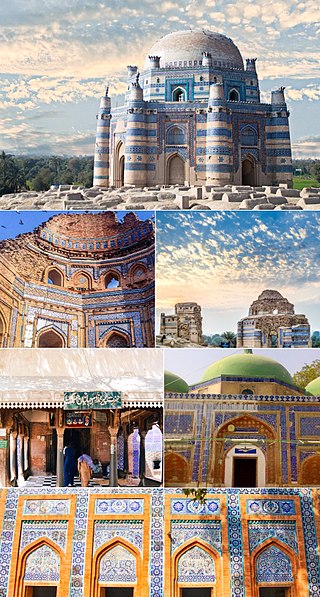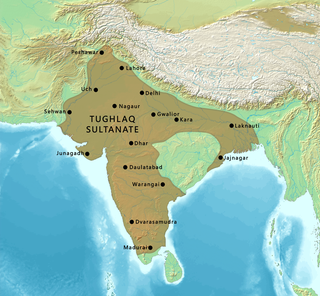
The Chishti order is a Sufi order of Sunni Islam named after the town of Chisht where it was initiated by Abu Ishaq Shami. The order was brought to South Asia by Mu'in al-Din Chishti in the city of Ajmer.

Sultan-ul-Mashaikh, Khwaja Syed Muhammad Nizamuddin Auliya, also known as Hazrat Nizamuddin, and Mahbub-e-Ilahi was an Indian Sunni Muslim scholar, Sufi saint of the Chishti Order, and is one of the most famous Sufis from the Indian Subcontinent. His predecessors were Fariduddin Ganjshakar, Qutbuddin Bakhtiyar Kaki, and Moinuddin Chishti, who were the masters of the Chishti spiritual chain or silsila in the Indian subcontinent.

Chishtī Muʿīn al-Dīn Ḥasan Sijzī (1143–1236), known more commonly as Muʿīn al-Dīn Chishtī or Moinuddin Chishti, or by the epithet Gharib Nawaz, or reverently as Shaykh Muʿīn al-Dīn or Khwāja Muʿīn al-Dīn, was a Sunni Muslim preacher, ascetic, religious scholar, philosopher and mystic from Sistan, who eventually ended up settling in the Indian subcontinent in the early 13th-century, where he promulgated the famous Chishtiyya order of Sunni mysticism. This particular tariqa (order) became the dominant Islamic spiritual order in medieval India. Most of the Indian Sunni saints are Chishti in their affiliation, including Nizamuddin Awliya and Amir Khusrow.

Sayyid is an honorific title of Hasanids and Husaynids Muslims, recognized as descendants of the Islamic prophet Muhammad through his grandsons, Hasan ibn Ali and Husayn ibn Ali, sons of Muhammad's daughter Fatima and his cousin and son-in-law Ali.

Sultan Firuz Shah Tughlaq was a Muslim ruler from the Tughlaq dynasty, who reigned over the Sultanate of Delhi from 1351 to 1388. He succeeded his cousin Muhammad bin Tughlaq following the latter's death at Thatta in Sindh, where Muhammad bin Tughlaq had gone in pursuit of Taghi the rebellious Muslim governor of Gujarat. For the first time in the history of the Sultanate, a situation was confronted wherein nobody was ready to accept the reins of power. With much difficulty, the camp followers convinced Firoz to accept the responsibility. In fact, Khwaja Jahan, the Wazir of Muhammad bin Tughlaq had placed a small boy on the throne claiming him to be the son of Muhammad bin Tughlaq, who meekly surrendered afterwards. Due to widespread unrest, his realm was much smaller than Muhammad's. Tughlaq was forced by rebellions to concede virtual independence to Bengal and other provinces. He established Sharia across his realm.
Nasir al-Din, was originally a honorific title and is a masculine given name and surname of Arabic origin. There are many variant spellings in English due to transliteration including Nasruddin, and Nasiruddin. Notable people with the title or name include:

Uch, frequently referred to as Uch Sharīf, is a historic city in the southern part of Pakistan's Punjab province. Uch may have been founded as Alexandria on the Indus, a town founded by Alexander the Great during his invasion of the Indus Valley. Uch was an early stronghold of the Delhi Sultanate during the Muslim conquest of the subcontinent. It is also known as the home for the Naqvi/Bukhari's after the migration from Bukhara. Uch was a regional metropolitan centre between the 12th and 17th centuries, and became refuge for Muslim religious scholars fleeing persecution from other lands. Though Uch is now a relatively small city, it is renowned for its intact historic urban fabric, and for its collection of shrines dedicated to Muslim mystics (Sufis) from the 12th-15th centuries that are embellished with extensive tile work, and were built in the distinct architectural style of southern Punjab.

The Tughlaq dynasty was the third dynasty to rule over the Delhi sultanate in medieval India. Its reign started in 1320 in Delhi when Ghazi Malik assumed the throne under the title of Ghiyath al-Din Tughluq. The dynasty ended in 1413.

Bihar Sharif is the headquarters of Nalanda district and the fifth-largest sub-metropolitan area in the eastern Indian state of Bihar. Its name is a combination of two words: Bihar, derived from vihara, also the name of the state; and Sharif. The city is a hub of education and trade in southern Bihar, and the economy centers around agriculture supplemented by tourism, the education sector and household manufacturing. The ruins of the ancient Nalanda Mahavihara, a UNESCO World Heritage Site, are located near the city.

Jalāl Mujarrad Kunyāʾī, popularly known as Shah Jalal, was a celebrated Sufi figure of Bengal. His name is often associated with the Muslim conquest of Sylhet and the Spread of Islam into the region, part of a long history of interactions between the Middle East, Central Asia, and South Asia. Various complexes and religious places have been named after him, including the largest airport in Bangladesh, Hazrat Shahjalal International Airport and numerous mosques around the United Kingdom.

The Jaunpur Sultanate was a late medieval Indian Muslim state which ruled over much of what is now the states of Uttar Pradesh and Bihar between 1394 and 1494. It was founded in 1394 by Khwajah-i-Jahan Malik Sarwar, an eunuch slave and former wazir of Sultan Nasiruddin Muhammad Shah IV Tughluq, amidst the disintegration of the Delhi Sultanate's Tughlaq dynasty. Centred in Jaunpur, the Sultanate extended authority over a large part of the Ganges-Yamuna Doab. It reached its greatest height under the rule of Sultan Ibrahim Shah, who also vastly contributed to the development of Islamic education in the Sultanate. In 1494, Sultan Hussain Khan was defeated by the forces of the Afghan ruler Bahlul Lodi, Sultan of the Lodi dynasty of the Delhi Sultanate at Benares at which point Hussain fled to Kahalgaon in modern-day Bihar where the Sultan of Bengal assigned him a pargana. Here he was allowed to mint his own coins and was promised help from Bengal in recovering his kingdom. He died in 1505.
Makhdoom is an Arabic word meaning "Teacher of Sunnah." It is a title for Pirs, in South and Central Asia.
Khwaja Usman Harooni was an early modern wali or Sufi saint of Islam in India, a successor to Shareef Zandani, sixteenth link in the Silsila of the Chishti order, and master of Moinuddin Chishti. Usman Harooni was born in Haroon, Iran. His year of birth is variously given as 1096, 1116 and 1131 AD. He is also known by the nicknames Abu Noor and Abu Mansur.

Khawajah Syed Qutbuddin Maudood Chishti was an early day Sufi Saint, a successor to his father and master Abu Yusuf Bin Saamaan, twelfth link in the Sufi silsilah of Chishti Order, and the Master of Shareef Zandani. He was born around 430 Hijri in the city of Chisht. He initially received education from his father. He memorized the Qur'an by age 7 and completed his education when he was 16. His work includes two books, Minhaaj ul Arifeen and Khulaasat ul Shariah. He died in the month of Rajab at the age of 97 in 533 AH. He was buried at Chisht like many of the early Chishtiyya.
Imam Ali al-Haq lived in the 10th century. He is referenced in a Persian manuscript by Ganesh Das Wadhera titled "Chār Bāgh-i-Panjāb", an account which is later published by Indu Banga and J. S. Grewal in their book "Early Nineteenth-Century Panjab." Imam Ali al-Haq led an army to Sialkot from Arabia between 965-971 A.D during the Samanid appointment of Bilgetegin. He was killed in Sialkot in a battle with Raja Sahan Pal, who assumed the title of Salbahan the second, in the course of his brothers rule of Sirhind.
Afghan Indians are Indian citizens and non-citizen residents born in, or with ancestors from, Afghanistan. As of early 2021, there are at least 15,806 Afghans temporarily residing in India under a special protection and care of the United Nations High Commissioner for Refugees (UNHCR). Apart from citizens and expatriates, there are a number of communities in India who trace their ancestry back to Pashtun forefathers of Pashtunistan.

Makhdoom Sharfuddin Ahmed bin Yahya Maneri, popularly known as Makhdoom-ul-Mulk Bihari and Makhdoom-e-Jahan (1263–1381), was a 13th-century Sufi mystic.













